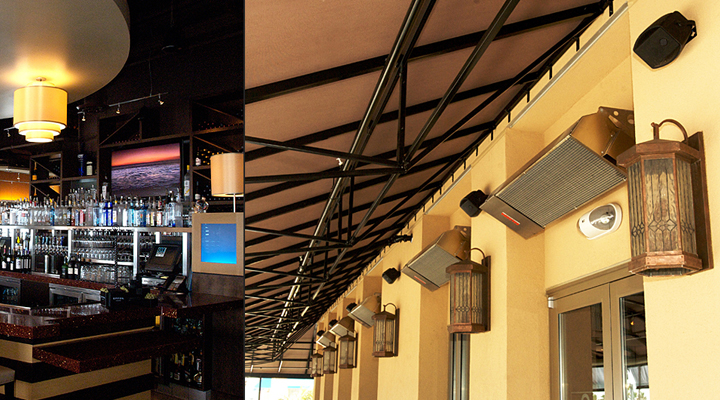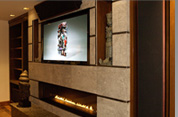
Glossary of Terms1080i – An HDTV standard that specifies an interlaced resolution of 1920×1080. 16:9 – Sometimes expressed as 16×9 or 16 by 9 (known as 1.78:1 in the film world); the standard DTV wide-screen television screen size, or aspect ratio–16 arbitrary units wide by 9 arbitrary units high, as compared to a standard TV aspect ratio of 4:3. The phrase describes the shape of a TV set or program, not an actual inch measurement. 4:3– Standard “square” NTSC TV screen-size aspect ratio of 4 arbitrary units wide by 3 arbitrary units high; often expressed as 4×3 or 4 by 3. It was originally known as the Academy Ratio (as in Academy of Motion Picture Arts and Sciences, the film industry organization that awards the Oscars) prior to 1954 and the introduction of wide-screen aspect-ratio film formats; also known in the film world as 1.33:1. 480i – 480 interlaced; form of standard-definition digital television (SDTV) that approximates the quality of analog television but not considered high-definition television (HDTV). Even though the native resolution of DVDs is 480p, they are viewed at 480i on an NTSC analog television. 480p – 480 progressive; form of standard-definition digital television (SDTV) comparable to VGA computer displays but not considered high-definition television (HDTV), though 480p is discernibly cleaner and slightly sharper than analog television. The native resolution of DVD is 480p, but that resolution can be seen only if a DVD player outputs a progressive-scan signal and the DTV has progressive-scan or component-video inputs; it is also known as EDTV. 5.1 channel digital surround sound – The popular digital surround-sound technique used by Dolby Digital technology in which audio is recorded on six, or 5.1, separate tracks: front left, front right, front center, rear left, and rear right, with an extra track (the .1) reserved for very low bass. This method (also called AC-3) mimics the three-dimensional quality of sound in real life and has become ubiquitous in home-theater systems. Although analog surround sound such as Dolby Pro Logic also often uses six speakers, the analog format simply splits a traditional stereo signal into front and rear components. 720p – 720 progressive. One of two currently used formats designated as high-definition television in the ATSC DTV standard, this technology comprises 720 vertical pixels and 1,280 horizontal pixels. The p stands for progressive, as opposed to interlaced, scanning, which is used in the other accepted HDTV standard, known as 1080i. Contrary to myth, 720p is not inferior to 1080i; 720p has fewer lines but also has the advantages of progressive scanning and a constant vertical resolution of 720 lines, making it better able to handle motion. Anamorphic – Adopted from the film technique of shooting a wide-screen image on a square 35mm frame, it’s the process of compressing wide-screen images to fit into the squarer standard 4:3 television signal. The images are then expanded for viewing in their original format on a wide-screen display device. Wide-screen or letterboxed DVDs that are not anamorphic have less detail when projected on a wide-screen monitor. In other words, a nonanamorphic wide-screen DVD is designed to be shown letterboxed on a standard “square” TV but appears with a black box all around the image when shown on a larger 16:9 wide-screen TV. To fill a 16:9 screen, a nonanamorphic DVD has to be blown up, resulting in loss of resolution and detail. Conversely, a DVD that is anamorphic, enhanced for 16:9, or enhanced for wide-screen delivers 33 percent more resolution than regular letterboxed transfers, is designed to be shown on a 16:9 TV, and does not need to be blown up. When one of these DVDs is shown on a “square” TV, it is often subject to anamorphic downconversion artifacts unless the TV has a vertical compression feature. Aspect Ratio – The ratio of width to height in a video picture or other graphic image. Standard U.S. TV broadcasts and computer monitors feature a 4:3 aspect ratio; HDTV has a much wider 16:9 ratio. Black Level – The intensity of black in the television picture, frequently referred to as brightness; adjusted to compensate for ambient room light. Black level is set with a TV’s brightness control using a PLUGE test pattern. Setting black level correctly is critical to overall picture quality, particularly the ability to see detail in dimly lit scenes of a movie. The term also refers to the ability of a display to produce an inky, deep black, which is often a problem in fixed-pixel displays. Burn In – occurs when an image such as a stock ticker, a network logo, or letterbox bars gets etched permanently onto the screen because it sits in one place too long. The danger of burn-in has been greatly exaggerated, and people with normal viewing habits have nothing to worry about. The potential for burn-in is greatest during the first 100 or so hours of use. Component Video – The elements that make up a video signal, consisting of luminance and two separate chrominance signals, expressed either as Y R-Y B-Y or Y Pb Pr. Composite Video – A type of video signal in which all the necessary video information is combined into one signal. This is the type of signal used for broadcast TV in the United States. Most computer monitors use RGB video, in which the red, blue, and green signals are sent separately to produce a sharper image. Contrast Ratio – The difference in light intensity between the brightest white and the darkest black that a display device can produce. A higher the contrast ratio is better than a lower one. CRT – Cathode Ray Tube EDTV – Enhanced Definition TelevisionAlso used to describe plasma and other fixed-pixel displays that have 852×480 resolution. They can show an HDTV image but don’t provide as much detail as higher-resolution displays. HDMI – High-Definition Multimedia Interface. USB-like digital video connectivity standard designed as a successor to DVI; can transmit both digital audio and video signals; incorporates HDCP digital copy protection. Interlaced Scanning – Scan method used by the majority of televisions and the 1080i HDTV format. As opposed to progressive scanning in which the CRT’s electron beam scans or “paints” all lines at once, interlaced scanning TVs paint odd-numbered lines in succession, then go back and fill in the remaining even-numbered lines. This method is more prone to artifacts and less stable than progressive. Judder – A visual artifact that often occurs when film is transferred to video. The result is what appears to be jerky or stuttering camera movement, where it should be a smooth pan LCD – liquid-crystal display A technology used in creating displays for notebook computers, tablet PCs, personal digital assistants (PDAs), mobile phones, and flat-panel monitors for PC systems. This type of display consists of an electrically reactive liquid-crystal substance sandwiched between two sheets of polarizing material. An electric current passed through the liquid causes the crystals to align so that light can or cannot pass through them, thus creating the images on the screen. LCD screens are slim and light and can be produced in a wide range of sizes. Lumens – The unit of measure for the light output of a projector. Different manufacturers may rate their projectors’ light output differently, and these numbers are usually inflated. “Peak lumens” is measured by illuminating an area of about 10 percent of the screen size in the center of the display. This measurement ignores the reduction in brightness at the sides and corners of the screen. Native Resolution – The resolution at which a TV or monitor is designed to display images. Image signals higher or lower than a specified native resolution must be converted to be displayed accurately. For example, a TV with a native resolution of 1080i can display 1080i images but may upconvert 480p images to 1080i. In contrast, a TV with a native resolution of 480p must downconvert a 1080i signal to 480p for display. CRT-based projection TVs can have more than one native resolution, but fixed-pixel displays such as LCD and DLP are limited to display one resolution and convert all others. Overscan – The amount of picture area that gets cropped off along the edges of a television screen. Zero percent overscan means the television does not crop off any of the incoming picture. Overscan is often set intentionally at the factory to be 5 percent, or even higher along the edges, to ensure the screen is full at all times regardless of fluctuations in brightness (which can change the overall picture size) or nonstandard signals, such as those from camcorders or video games. Progressive Scan – A method of displaying images on a CRT monitor or a high-definition TV in which all the lines of a picture are drawn in one quick burst, from left to right and from top to bottom. Compare this to interlacing, in which every other line is displayed in two successive swoops to form a complete picture. RCA Connectors – This type of connector is used mainly for carrying video and line-level audio on stereos, TVs, VCRs, and video cameras. The connector has a center contact (a pin or a hole) and an outer contact (a flower or a cylinder). Refresh Rate – The speed at which the pixels on a display device can change. Wide-Screen – Image with an aspect ratio greater than 1.33:1 or a picture wider and narrower than a standard television image. Typically refers to TVs in the 16:9 aspect ratio. |










